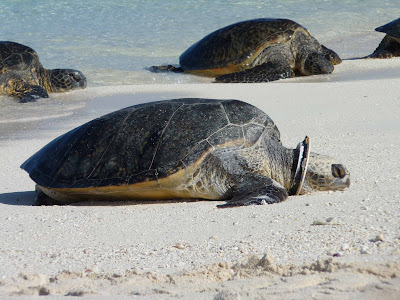Shew, the past couple weeks have been busy!!!
CORAL: FWS Volunteer Lindsey Kramer prodded us all out in the water at the crack of dawn, boating over to Shark Island (a couple miles from Tern Island) for early morning snorkels. She wanted to be the first person to witness cauliflower coral spawning in the Northwestern Hawaiian Islands. And guess what? It took a snorkeling a couple mornings in the frigid waters of April, and then a couple mornings in the warmer waters of May -- but she did it!!! We were able to be the very first witnesses of cauliflower coral spawning on May 18th, with more spawning occurring on May 19th. Way to go, Lindsey!!!
 |
| Photos by Paula L. Hartzell |
SEALS: We've had some gains and losses in the ʻilio o ke kai world... Some new pups, and some pups are gone. One nice event occurred when one of the seal crew, Ben Cook, was camping out on Gin Island last week. (The seal crew guys take turns staying out on the islands to watch out for the pups.) A first time seal mom give birth – and then as the mom and pup failed to bond. The pup wandered off looking for the mom, who was fairly unresponsive. The pup then got caught and battered in the surf. Ben was able to rescue the pop, and reunite the pair for the first nursing, which is the critical bonding period for these seals. The new mom accepted the pup, and it looks like they’re doing well. The pup likely would have died without intervention, so we’re really glad Ben was out there.
OUTREACH: We have to send out a special thanks to our new Education and Outreach Coordinator, Barbara Mayer, who has been working on curriculum for teachers to use this Fall. An established curriculum and lesson plans will help teachers -- who are already overworked -- have an easier time working information on the Northwestern Hawaiian Islands and Kānemilohaʻi into their classrooms. That should be great fun for the kids! Barbara is also working with ʻIolani School for a Marine Debris class this summer -- so those of us on Tern are also busy collecting some marine debris, empty bird eggs, and the like to send back for the class. She's also the one responsible for making the blog more organized and functional. Mahalo nui e Barb!
TURTLES: We counted 412 basking turtles on East Island this week!!! This is fantastic -- and pretty amazing, considering the whole island is about 200 meters (650 feet) long!
 |
| Honu on East Island. We counted a remarkable 412 basking turtles at one time on East Island on Thursday this week. Photo by Paula L. Hartzell. |
BIRDS:
We completed our first estimate of the ʻewaʻewa (sooty terns) on Tern Island. There are about 133,000 adults and 32,500 eggs on island now -- That is one big bunch of ankle biters.
 |
| ʻEwaʻewa (sooty tern). Now multiply this by 133,000 on an island a half mile long by a quarter mile wide. Now imagine each and every one pecking your head and ankles. :-) Photo by Paula L. Hartzell. |
The last Tristram’s storm petrel fledged from artificial nest boxes this week! FWS Volunteer Sarah Youngren has documented a strong relationship in patterns in weight gain and loss immediately prior to fledging, allowing us to accurately identify when a chick is ready to fledge. We have made enormous strides in development of consistent, replicable, quantitative method for monitoring TRSP; we have vastly reduced the number of human-crushed burrows; and look forward to development of adult population monitoring next year, thanks to Sarah’s hard work over then last two years – and on into next year. Good work, Sarah!
BUILDING NEWS: FWS Volunteer has constructed a new shade-house on the back-porch, and is adding a roof to our front porch. The shade-house will be used to grow native plants, which is sorely needed to give a boost to the shrubs on Tern Island. Birds need the shrubs for nesting habitat, shade, and to consolidate soil around burrows. Thanks, Curt, for getting all this built!
TEAM TERN:
 |
| ʻĀ (red-footed booby) chick and its parent squash in for room on the nest. Photo by Sarah Youngren. |
 |
| Photo by Paula L. Hartzell. |
 |
| Laughing kaʻupu. (Black-footed albatross.) The chicks have their adult feathers on their bodies now, and getting some pretty funny hairstyles up top. |
 |
| Brown booby contemplates a fine day off of East Island. Photo by Mark Sullivan. |
 |
| Lindsey Kramer (top) and Mark Sullivan (bottom) waiting for coral to spawn. |










What a great post, interesting, detailed and answered a bunch of questions I had. Glad you folks are out there taking care of business and those little trouble maker pup's and half-feathered albatross's. Hope the weather stays nice and not too hot and the ocean not to cold. Thank you again!
ReplyDelete